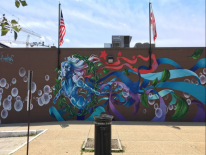Then I saw a new heaven and a new earth; for the first heaven and the first earth had passed away, and the sea was no more. (Revelation 21:1)
Biblically-minded urbanists know that the Bible begins in a garden and ends in a city. This is true for Jews as well as Christians: The Hebrew Bible ends in Jerusalem in about 430 BCE, with Nehemiah having returned from Persia to administer the rebuilding of the holy city, and incidentally to purge the city of foreigners and punish those Israelites who had married foreign women. And I contended with them and cursed them and beat some of them and pulled out their hair... (Nehemiah 13:25a). Not exactly Mister Rogers.
 |
| Icon of Nehemiah (Source: Wikimedia commons); I'm looking closely for hanks of someone else's hair |
Sovereign Lord, holy and true, how long will it be before you judge and avenge our blood on the inhabitants of the earth? (6:10)
 |
| The beast with the lamb's horns and the beast with seven heads, from Revelation 13-14 woodcut by Albrecht Dürer, c. 1497-1498 (Wikimedia commons) |
It is tempting to imagine how ducky life would be if only we could get rid of the people we don't like--maybe it could be as ducky as described in the last two chapters of Revelation! Most of us can only wish ill on our "enemies," but given enough might or enough money or the force of law some of us can attempt to act on those wishes. When the U.S. moved its embassy in Israel to the disputed city of Jerusalem this spring, it made me think of the fantasy of the New Jerusalem, particularly after Israeli forces responded with such violence to the inevitable protests in Palestinian ghettos. The same impulse--to build a paradise while ignoring or excluding the other--fueled the suburban model of development. That may not have proven as futile as the prejudices that fuel the Middle East, but it's come with its own set of high costs that Americans are only beginning to acknowledge.
Exclusion never works as neatly as its advocates think it ought to. Neither does the "shock-and-awe" approach. There's no magic formula for getting along, either, but if we can't afford to build long enough roads or high enough walls to keep everybody apart, we're going to have to learn how to live with difference. During my last weekend in Washington, I found myself reading these words at the Martin Luther King memorial.
The quotation is from Dr. King's sermon at Ebenezer Baptist Church on Christmas Eve 1967. It came at a time when he was getting pushback for expanding the scope of his civil rights activities to include poverty and the war in Vietnam. King saw, maybe sooner than others did, how modern life connects us all, however we might feel about that.
It really boils down to this: that all life is interrelated. We are all caught in an inescapable network of mutuality, tied to a single garment of destiny. Whatever affects one directly, affects all indirectly. We are made to live together because of the interrelated structure of reality. Did you ever stop to think that you can't leave for your job in the morning without being dependent on most of the world?

I began blogging more than five years ago, believing in these times we--we in our town, we in our country, we on the planet Earth--have no choice but to learn how to live together, to listen to and learn from each other. I also know that this is not easy, but there are people who are trying to make this happen, and places where progress is being made. Further, there are social arrangements--the physical design of a town, the way an economic system structures opportunity, inclusion across differences--that facilitate or obstruct our lives together.
This continues to be my project. It has forced me out of a comfortable academic abstract objectivity, and has meant that I'm writing for someone other than the American Political Science Review. If you've read this far, I'm writing for you! and thank you for your time and your thoughtful responses.
Of the previous 299 posts, the most popular are from fall 2016.
- A Silent But Needful Protest, 1 November 2016 [Coe College responds to the defacing of Multicultural Fusion posters]
- Snout Houses? In Oakhill-Jackson??, 16 October 2016 [Suburban style development in a historic Cedar Rapids neighborhood]
- Crime and Our Common Life, 1 August 2016 [The mysterious rise and fall and possibly now rise of violent crime rates in America]
- Let's Hear It for Cedar Rapids, 5 September 2016 [The Mayors Bike Ride and everything else going on Labor Day weekend]
- Is Our Children Learning? 15 August 2016 [inverse correlation of student poverty with school test scores]
With one exception--hey, what's up with that?--the least popular are short pieces from the early years.
- Halloween 2013, 1 November 2013 [Halloween as civic holiday]
- Nothing Says Community Like..., 13 January 2014 [Take your Christmas tree to this parking lot and it will be made into trails]
- A Holiday Tradition, 24 November 2013 [Christmas at Brucemore National Historic Site]
- Downtown Construction Continues, 23 September 2014 [early stages of the CRST building]
- King Street That Complete Street, 27 April 2018 [Alexandria VA redesigns its main drag]
























































